Spring or fall normally wins the honor of being everyone’s favorite season to train in… but trust us when we say that summer does have a lot going for it.
Research shows that running in the heat can help us prepare for races that take place in hot weather, even better, running in high temperatures can lead to improved overall fitness.
The key is to know how to train safely in the heat, which is exactly what we’re going to teach you in this article.
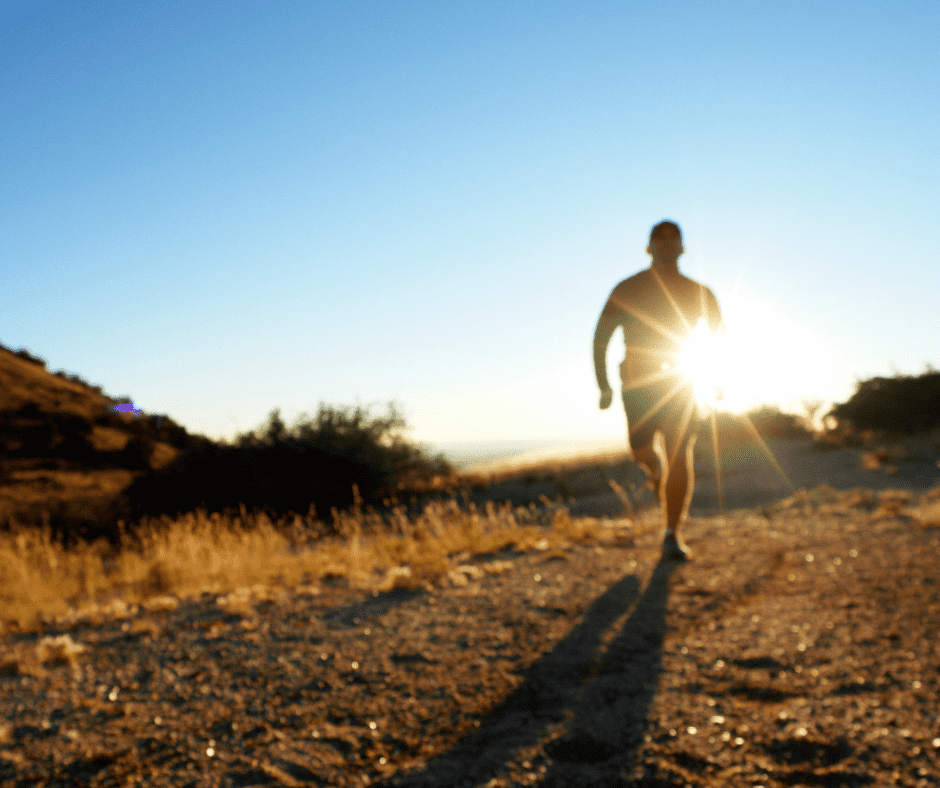
Is It Ok To Run In Hot Weather?
There is the possibility of serious health consequences to exercising in the heat and humidity, such as heat exhaustion and heat stroke. But these can be avoided if you listen to your body and take sensible precautions…
Yes, running in hot weather does present several risks but it is okay to run in hot weather if you drink enough fluids to stay hydrated, avoid running at the hottest times in the day (between 11 am and 3 pm), wear breathable clothing, and by slowing down your normal pace.
Let’s have a look at how you can run in the heat and not get too affected by the hot conditions…
How To Run In Hot Weather
We’ve all had that situation where we’ve been training for a race or an event and we’ve been training at home or wherever we live, and then arrive at the event and it’s a good a few degrees hotter than what we’re used to…
For example, say it’s a bit more humid, and you end up struggling on race day. The good news is there is a way to mitigate that.
What makes running in hot conditions so challenging?
Very simply, our bodies struggle once they get too hot to function, because the proteins that we rely heavily on in terms of the integrity and structure of our cells, and some of the functioning of our cells, start to degrade when it gets too hot.
Temperature and altitude are the two biggest hindrances to running performance.
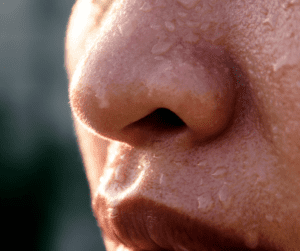
Once you get into a very hot environment, your body starts to struggle to get rid of the heat…
Remember when we are exercising, we are like little engines. So think of yourself as a steam train. The more energy you need, the hotter that furnace is going to burn. Then you need to get rid of that heat.
If you cannot get rid of the heat, we call it down-regulating your body will force you to, it sends out a signal and you will start to feel bad, this is because your body is trying to slow down the intensity so it can ‘turn the stove down.
If your body doesn’t ‘turn the stove down’, you stand the chance of experiencing physiological stress, which is very dangerous.
You want to be able to manage this process…
We can do several things to regulate our temperature while running in hot environments:
- The first part and the easiest part is to immediately do things to ourselves to keep cool.
We do lose a lot of heat from our forehead and of course, when you’re exercising in a hot, humid environment, the first thing you should be doing is putting on a hat.
That hat protects you from the sun, right?
The sun of course does its damage. So we would not suggest running without a hat, but you’re now blocking one of the very efficient places for your body to lose heat…
We recommend keeping your hat wet and cool so that it can still act as a conductor and you can lose heat at the top of your head.

- Keep your skin wet and cool.
If you do keep your skin wet with water and cold water, in particular, that is a really good way for your body to release heat.
If you’re exercising in a very hot but dry environment. It’s not nearly as severe because you could lose loads of heat from evaporative cooling.
This is when you need to run in very light clothing.
The best type of clothing for running in the heat is made from moisture-wicking material that quickly takes stuff to the surface and evaporates and when it evaporates there’s a lot of cooling that takes place.
In very hot, humid environments that doesn’t happen. This is when using cool fluids becomes very important to regularly douse yourself with.
There are some garments on the market at the moment. The one that I’ve personally experimented with is E-Cooline, but there are a couple.
What they have done with those garments, is they have bandanas, caps, arm sleeves and a T-shirt, they are like shirts essentially but they are a little bit thicker and they have a substance that when it becomes wet, a chemical reaction forms, which causes that suit to cool down.
- Losing heat through your neck is also an extremely effective way.
If you have a buff on you, you can keep it wet and cold.
If you’re in extremely hot conditions, you can take a pair of stockings, and put blocks of ice inside the stockings to hang around your neck. It will slowly melt and drip down your t-shirt.
- We can also prepare our bodies to cope better with the heat.
In two ways essentially:
- Exercise in heat.
This will cause adaptations that teach our body to cool much more efficiently in those types of conditions.
You can do this by running in the middle of the day or during the hottest part of the day.
Please use suntan lotion, and wear a cap and sunglasses to protect yourself from the sun.
Or, you can hop on a treadmill and train in a very heated room.
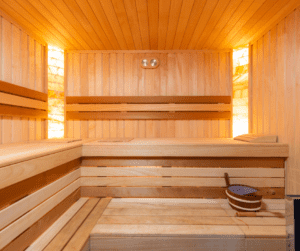
If none of the above work for you you could even get into a sauna. This would work if you spend between 10 and 30 minutes, for two sessions a week.
Those two sessions a week will cause a lot of physiological changes that will make you far better able to cope with exercising and racing in hot and humid environments.
Let’s see how long that adaptation would take?
Imagine you were doing a goal race that was in a climate a lot hotter than you are used to. It’s very similar to trying to adapt to altitude.
Essentially, when you move to altitude, once you’ve been there for six hours you’re more adapted than you were when you arrived.
When you’ve been there 12 hours, so on and so forth until probably seven to 10 days you get full adaptation.
For the race, you should go to the location about 10 days before the race and you’ll undergo quite a lot of adaptation. That said, sauna sessions will make the same adaptations.
We understand that it’s not always practical to get to a destination race 10 days before, that is why prepping accordingly beforehand becomes that much more important.
How To Deal With The Heat During The Comrades Marathon
You want to keep your body temperature down. There are loads of water tables along the Comrades Marathon route.
Most of the water sachets stay in big baths with ice. So I would advise you to keep your body temperature down by keeping yourself wet pretty much the whole way. Take every opportunity you can to put ice on your skin. It is your skin temperature that you want to control.
Runners from up north are at an enormous disadvantage and truthfully there is not a massive amount you can do other than doing some heat acclimatization by training in a hot, potentially humid environment.
Most importantly though is to manage yourself on race day and of course if you keep dousing yourself with water, blistering is going to be a potential issue on your feet. So you’ll want to put some added protection around your feet like plasters or Vaseline.
Benefits Of Running In Heat & Humidity
It has been proven that training in the heat (with the correct safety precautions taken) can increase your blood plasma volume (which leads to better cardiovascular fitness), reduce your overall core temperature, reduce blood lactate, and increase your skeletal muscle force.
This will all have a massive positive impact on your training in colder conditions.
According to Santiago Lorenzo, a professor of physiology at Lake Erie College of Osteopathic Medicine and a former decathlete at the University of Oregon. Heat training not only does a better job at increasing V02 max than altitude, but it also makes athletes better at withstanding a wider range of temperatures.
Running in heat and humidity is the same as training at altitude. This is because running in hot weather puts stress on your cardiovascular system making your heart stronger. It also decreases blood flow to muscles because the blood is going to your skin instead, making training similar to that in high elevations.
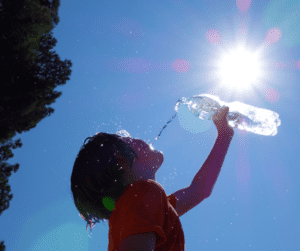
Dangers Of Running In Hot Weather
Running in hot weather can pose dangers to runners…
- Dehydration
While running, your body loses fluids through sweat. If you don’t replace those fluids by drinking water or other liquids, you can become dehydrated.
In hot conditions, we do need to add some electrolytes or even a pinch of salt to our water, to ensure we absorb that water better, otherwise, it just sweats right through us.
Also, higher sweat rates require higher fluid intake
The BEST Marathon Hydration Strategy According To Experts
- Heat Cramps
These are painful, involuntary muscle spasms that usually occur during heavy exercise in hot environments.
- Heat Exhaustion
This is a very serious condition that can lead to heatstroke.
The symptoms of heat exhaustion are:
- Dizziness
- “Goosebumps” (particularly on the torso and arms)
- Nausea (sometimes accompanied by vomiting)
- Moderate to severe headache
- Weak legs
- Lack of coordination
- Rapid pulse
- Heatstroke
Heat stroke is the most serious heat-related illness. It occurs when the body can no longer control its temperature. The body’s temperature rises rapidly, the sweating mechanism fails, and the body is unable to cool down.
- Hyponatremia
This occurs when the level of sodium in the blood is too low.
With this condition, the body holds onto too much water. This dilutes the amount of sodium in the blood and causes levels to be low.
Now that we know the risks that come with running in heat and humidity, let’s see how we can avoid those risks and run safely…
Tips For Running In Heat & Humidity
- Avoid dehydration: You can lose between 6 and 12 oz. of fluid for every 20 minutes of running, especially when it’s hot.
- Prehydrate: Drink 10–15 oz. of water 10 to 15 minutes before running, and drink water every 20–30 minutes during your run.
- Add some electrolytes or even a pinch of salt to your water, to ensure that you absorb the water better.
- Try the trails: When the temperatures rise, asphalt and concrete absorb heat and radiate it back into your face. Trail running usually offers shade from trees
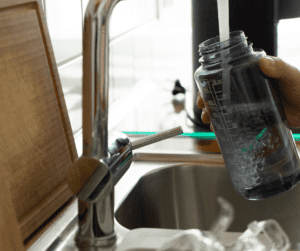
- Carry water: Use water bottles, a hydration vest, or a fuel belt to carry water with you.
- Take it easy: Take the weather conditions into account. Brutal heat and humidity mean that you should scale back your goals for the day.
- Know the signs of heat illness & stroke and if you do not feel better, get home or call for help.
- Splash yourself where possible: Use water to cool yourself.
- Dress for the weather: Your running clothes, socks included, should be made of a wicking technical fiber, choose lightweight, loose-fitting clothing. Wear a hat with a significant brim to keep the sun off your face. Wear a pair of lightweight sunglasses designed for sports activities.
- Apply sunscreen.




Comments are closed.